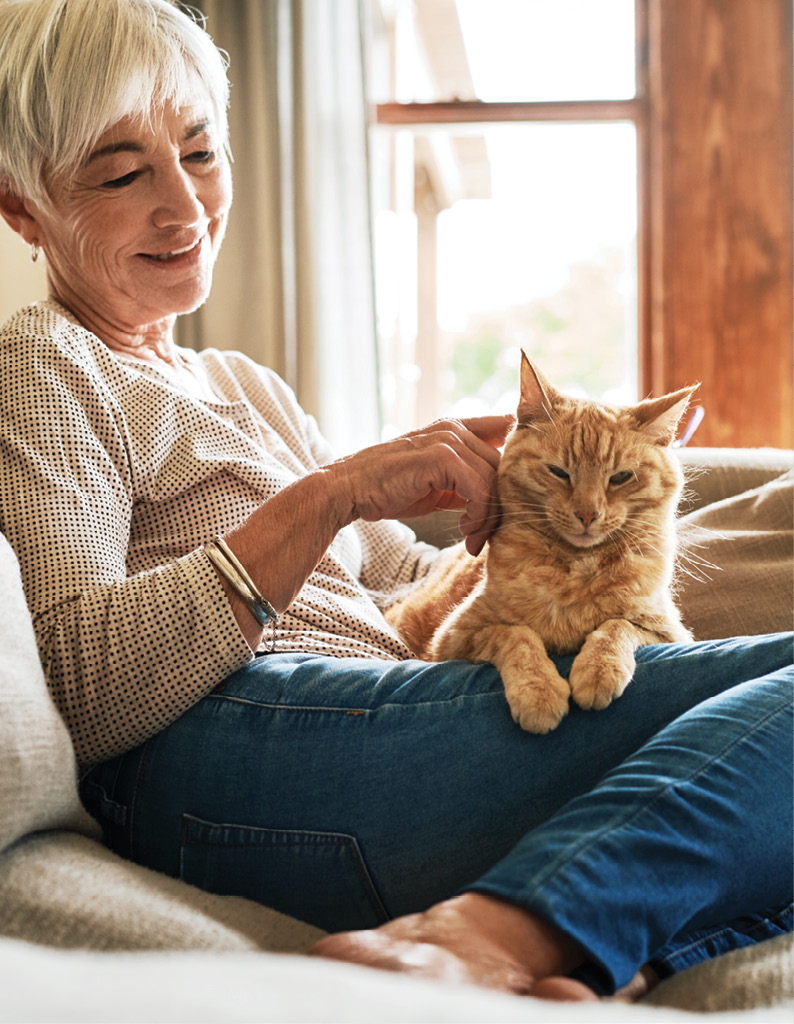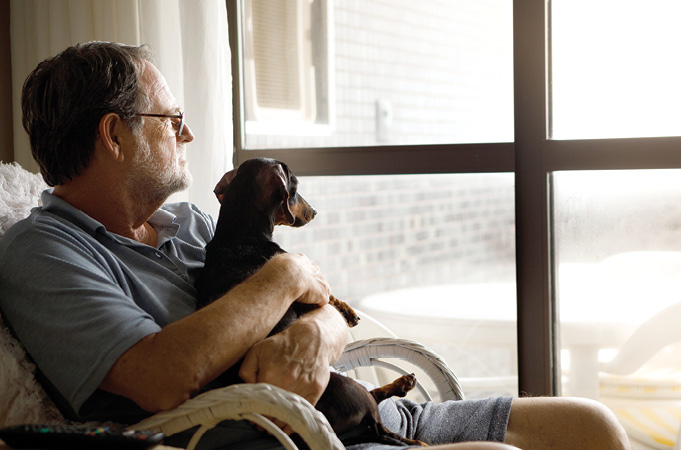Serving Seniors
Caring for the Individual Needs of Senior Clients and Their Pets

While many older Americans enjoy having pets and reap the health benefits of compassion animals, the reality is that caring for a pet can become more challenging with age.
Pets are becoming increasingly popular with older Americans, and for good reason. According to Pets for the Elderly, a nonprofit that provides companionship to seniors through pet ownership, numerous studies have shown that pets provide health benefits to seniors including increased physical activity and a decreased risk of heart disease and loneliness.

 "Companion animals can be very important to a senior citizen’s quality of life,” said Emma Grigg, MA, PhD, a certified applied animal behaviorist and lecturer and research associate in the Department of Population Health and Reproduction, at the University of California, Davis, School of Veterinary Medicine. “Our pets provide companionship, a sense of security, and motivation to exercise and can facilitate social interactions with neighbors and others.”
"Companion animals can be very important to a senior citizen’s quality of life,” said Emma Grigg, MA, PhD, a certified applied animal behaviorist and lecturer and research associate in the Department of Population Health and Reproduction, at the University of California, Davis, School of Veterinary Medicine. “Our pets provide companionship, a sense of security, and motivation to exercise and can facilitate social interactions with neighbors and others.”
Pet ownership among seniors is also on the rise. According to the National Poll on Healthy Aging, 59% of those ages 50 to 90 that completed the poll are pet owners and 10% of pet owners between 50 and 80 got a new pet during the pandemic. In addition, by the year 2050, 22% of the American population will be 65 or older. Since senior citizens are the fastest growing population in this country, the number of senior pet owners is also expected to rise significantly.
Yet while many older Americans enjoy having pets and reap the health benefits of compassion animals, the reality is that caring for a pet can become more challenging with age.
“With the growing number of older pet owners, veterinarians need to take under consideration both the health of the pet and their aging owner,” said Kimberly Pope-Robinson, DVM, owner of 1 Life Connected.
As an example, Pope-Robinson cautions against making assumptions.

 “If a senior client needs to give their cat medication twice a day, vet staff should ensure the client can open the pill bottle,” she said. “Or if a dog needs to have their ears cleaned on a regular basis, it’s important to determine if the owner is capable of doing that task or if they’ll need help.”
“If a senior client needs to give their cat medication twice a day, vet staff should ensure the client can open the pill bottle,” she said. “Or if a dog needs to have their ears cleaned on a regular basis, it’s important to determine if the owner is capable of doing that task or if they’ll need help.”
Pope-Robinson recommends that vet staff first demonstrate a procedure such as ear-cleaning to their senior clients and then observe the client completing the procedure.
“If the pet owner needs help caring for their pet, the vet staff might arrange a pet taxi that brings the client’s dog or cat to the clinic on a regular basis for ear-cleaning,” Pope-Robinson said. “Another option is mobile veterinary services that provide ear-cleaning and other pet care services at the client’s home.”
Pope-Robinson, who gave a talk on the special needs of elderly animal owners at the 2018 AVMA Convention, said she sees a lot of opportunities for veterinarians to improve care to senior pet owners and their companion animals.
“Senior pet owners are a rapidly growing demographic, and we need to talk more about how to best offer them veterinary services while also preserving the bond between older pet owners and their companion animals,” she noted.
For April Rogers, DVM, owner of Dr. April’s Hollywood Mobile Vet in Los Angeles, California, seeing senior clients is a regular part of her day. Rogers said those who no longer drive or who don’t live close to a veterinary office appreciate the convenience of having a mobile vet make house calls.

 After working in both an emergency and traditional veterinary care setting, Rogers decided to launch her own mobile business. She said visiting pets in their home also allows her the opportunity to assess how pet care is going and serves to reduce stress among both pet owners and their companion animals.
After working in both an emergency and traditional veterinary care setting, Rogers decided to launch her own mobile business. She said visiting pets in their home also allows her the opportunity to assess how pet care is going and serves to reduce stress among both pet owners and their companion animals.
“Convenience is a huge factor for my senior clients,” Rogers said. “Mobility issues can be an issue for both pets and their owners and seniors may no longer be able to lift or transport their pet safely.”
Rogers said it’s good business for veterinarians to either consider adding a mobile aspect to their practice or partner with a local mobile vet.
Ways to Help Make Pet Care Affordable for Seniors |
|
|
There’s no question that dogs, cats, and other animals can provide positive health benefits and companionship to seniors. Veterinary practices can help to support this bond by ensuring seniors have access to affordable pet care. In addition to veterinary care, low-income seniors need food, medicine, and supplies for their pets. Here are some cost-effective ideas to share with clients: Discounted Medications: If a pet has a chronic health condition or requires several preventive medications, the cost can be prohibitive for many low-income seniors. Consider writing your client a prescription they can fill at an online discount pharmacy such as 1-800-PetMeds or PetCareRx. Bonus: in addition to saving money, the prescriptions offer the convenience of being shipped directly to the client’s home. Safety: While studies have shown the numerous health benefits of seniors having pets in their life, some research has shown that injuries linked to dog walking are common and can lead to life-changing fractures in older adults. Veterinary staff can recommend ways for their senior clients to walk their dogs safely including using a cane or walking stick in their other hand for increased stability and ensuring they have a proper leash and collar for their dog to prevent pulling. Many shelters also offer behavior training classes for dogs at discounted prices. Food: Many churches and animal shelters offer free pet food pantries to low-income seniors and their pets. A guide to pet pantries in each state can be found at resources.bestfriends.org/article/financial-aid-pets. Vaccinations: If a senior client has a pet that needs vaccinations, consider referring them to a local Pet Food Express or Petco as many locations hold low-cost vaccination clinics on a regular basis. Microchipping: Many animal shelters offer discounted prices on microchipping for pets, a service that can offer seniors peace of mind in the event that their pet gets lost. |
|
“It’s a win-win for both brick-and-mortar vet clinics and mobile vets,” Rogers explained. “I can’t offer services such as X-rays or surgery, but I have veterinarians I refer to my clients. In addition, if these vet clinics have senior patients who would prefer to have someone come to their home for a wellness exam or to perform euthanasia services, they refer them to me.”
Since Rogers runs a paperless clinic, she can also easily forward an animal’s medical records in the event they need to be seen in an emergency. If the owner isn’t able to drive their pet to an emergency vet, Rogers can arrange for a transport via a pet taxi.
Taking Vet Care Directly to Senior Citizens and Their Pets

 In Texas, under the supervision of Lori Teller, DVM, clinical associate professor in the CVMBS’ Small Animal Clinical Sciences (VSCS) department, veterinary students at Texas A&M University’s College of Veterinary Medicine and Biomedical Sciences (CVMBS) are taking veterinary care directly to senior citizens who live in rural Bastrop County.
In Texas, under the supervision of Lori Teller, DVM, clinical associate professor in the CVMBS’ Small Animal Clinical Sciences (VSCS) department, veterinary students at Texas A&M University’s College of Veterinary Medicine and Biomedical Sciences (CVMBS) are taking veterinary care directly to senior citizens who live in rural Bastrop County.
The project, launched in January, hopes to ease some of the financial and access issues faced by senior pet owners. Teller says the project is funded by a grant from Petco Love and allows veterinary students to visit seniors and their pets in the rural community once a month.
“We can schedule telemedicine rechecks in between for those comfortable with that modality,” Teller said. “We also provide wellness services and can treat minor conditions such as skin, ear, and eye problems as well as some chronic conditions such as osteoarthritis, allergies, behavioral problems, and obesity.”
Teller said the project doesn’t provide in-patient pet care, dental care, or treatment for more advanced medical problems. They do partner with another organization to provide low-cost spays and neuters to seniors and their pets.
“Because this is a population with very limited financial means, providing a way to minimize their costs is important,” Teller said.
She recommended that veterinary practices consider offering their senior clients a variety of treatment choices and explaining the benefits and limitations of each. Some veterinary clinics also offer their senior clients a 10–20% discount on services.
“A stepwise approach to providing care is very important,” Teller said. “Some are not capable of driving and rely on family or friends for transportation. For clients who are comfortable with using their smartphones or who have a computer, utilizing telemedicine in some cases can be very helpful for follow-up visits.”

“Because this is a population with very limited financial means, providing a way to minimize their costs is important.”
—LORI TELLER, DVM
Teller said the project places a strong emphasis on patient education, with veterinary students reviewing wellness and preventive care with each pet owner.
“Every dog gets tested for heartworm disease and every cat is tested for feline leukemia and FIV unless the owner declines,” Teller said. “We discuss heartworms, other internal parasites, and external parasites and review diet and weight problems and address other questions or concerns a pet owner might have. “
Since cost is a major concern for many senior pet owners, Grigg recommended informing clients about assistance programs that can help pay for vet care, food supplies, and even grooming and dog walkers.
“Many shelters offer free vaccine clinics and/or free behavior counseling and reduced adoption fees for seniors,” Grigg said. “Some organizations, including the Sacramento SPCA, offer free seminars on estate planning and pet trusts to help seniors determine who will care for their companion animal if they can no longer care for them.”
To make a veterinary clinic more accommodating for seniors, Grigg suggested:
- Making physical access easier via handrails on steps and walls, avoiding trip hazards, creating high-contrast signage, and providing chairs with armrests to make getting in and out of them easier.
- Scheduling appointments at quieter times of the day to allow for patience and time for discussion and/or providing appointment windows instead of exact times as transportation can be challenging and public transportation is not always reliable.
- Providing handouts and instructions in large, bold, and high-contrast fonts on brightly colored paper and asking the client to post any instructions prominently in their home (such as on the refrigerator).
- Making sure printing on prescription labels is large enough to be read and followed correctly by the client.
- Using easy-open containers as joint problems can make opening child-proof containers challenging.
- Securing a secondary contact for communications about the pet (a spouse, family member, caregiver, etc.). This person can assist the client in caring for their pet, providing accurate medical history, etc.
- Making a calendar for the client to take home with dates when medicines and/or upcoming recheck visits are due.
Grigg also encouraged veterinary staff to have relevant resources on hand if a senior client expresses anxiety about what will happen to their pet if they can no longer care for them. Petfinder offers an extensive list of resources and options for pet owners to consider.
 |
Linda Childers is a freelance writer whose work has been published in The Washington Post, AARP, The Rheumatologist, Allure, Arthritis Today, AKC Family Dog, and other national media outlets. |
Photo credits: Dean Mitchell/E+ via Getty Images; Capuski/E+ via Getty Images



